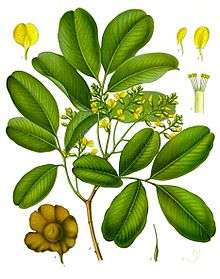Pterocarpus marsupium
| Pterocarpus marsupium | |
|---|---|
 | |
| Scientific classification | |
| Kingdom: | Plantae |
| (unranked): | Angiosperms |
| (unranked): | Eudicots |
| (unranked): | Rosids |
| Order: | Fabales |
| Family: | Fabaceae |
| Subfamily: | Faboideae |
| Tribe: | Dalbergieae |
| Genus: | Pterocarpus |
| Species: | P. marsupium |
| Binomial name | |
| Pterocarpus marsupium | |
| Synonyms | |
| |
Pterocarpus marsupium, also known as Malabar kino,[3] Indian kino tree or Vijayasar, is a medium to large, deciduous tree that can grow up to 30 metres (98 ft) tall. It is native to India, Nepal, and Sri Lanka, where it occurs in parts of the Western Ghats in the Karnataka-Kerala region and also in the forests of Central India. It is also known by the names benga, bijiayasal (in western Nepal), piasal (Oriya), venkai, and many others.
Uses
Parts of the Indian kino (heartwood, leaves, flowers) have long been believed to have medicinal properties in Ayurveda.
In Karnataka, the plant is known as honne or kempu honne. The Kannada people in India make a wooden tumbler from the heartwood of this herb tree.
A 2005 pharmacological study found that Vijayasar extract constitutes an effective blood glucose-lowering agent and may be useful in diabetes treatment.[4]
References
- ↑ World Conservation Monitoring Centre (1998). "Pterocarpus marsupium". IUCN Red List of Threatened Species. Version 2006. International Union for Conservation of Nature. Retrieved 11 May 2006. Listed as Vulnerable (VU A1cd v2.3)
- ↑ http://www.theplantlist.org/tpl/record/ild-31229
- ↑ "Pterocarpus marsupium". Natural Resources Conservation Service PLANTS Database. USDA. Retrieved 15 October 2015.
- ↑ Hariharan, R.S.; Venkataraman, S.; Sunitha, P.; Rajalakshmi, S.; Samal, K.C.; Routray, B.M.; Jayakumar, R.V.; Baiju, K.; Satyavati, G.V.; Muthuswamy, V.; Gupta, A.K. (2005). "Efficacy of vijayasar (Pterocarpus marsupium) in the treatment of newly diagnosed patients with type 2 diabetes mellitus: a flexible dose double-blind multicenter randomized controlled trial". Diabetologia Croatica. 34 (1): 13–20.
| Wikimedia Commons has media related to Pterocarpus marsupium. |
